Comparative Analysis of Business Structures in the UK: Recommendations
VerifiedAdded on 2023/06/08
|9
|2472
|225
Report
AI Summary
This report provides a comprehensive overview of business structures in the United Kingdom, analyzing sole proprietorships, partnerships, limited liability partnerships, and limited companies. It explores the legal frameworks governing these structures, referencing the Companies Act 2006 and other relevant legislation. The report delves into the advantages and disadvantages of each structure, considering factors such as liability, taxation, and administrative responsibilities. The context of the UK business environment is also discussed, highlighting its attractiveness and safety for conducting business. The report concludes with a recommendation for IOM solutions, suggesting the most suitable business structure for expansion based on the analysis and the business's specific circumstances. The report is a valuable resource for understanding the landscape of business organizations in the UK.
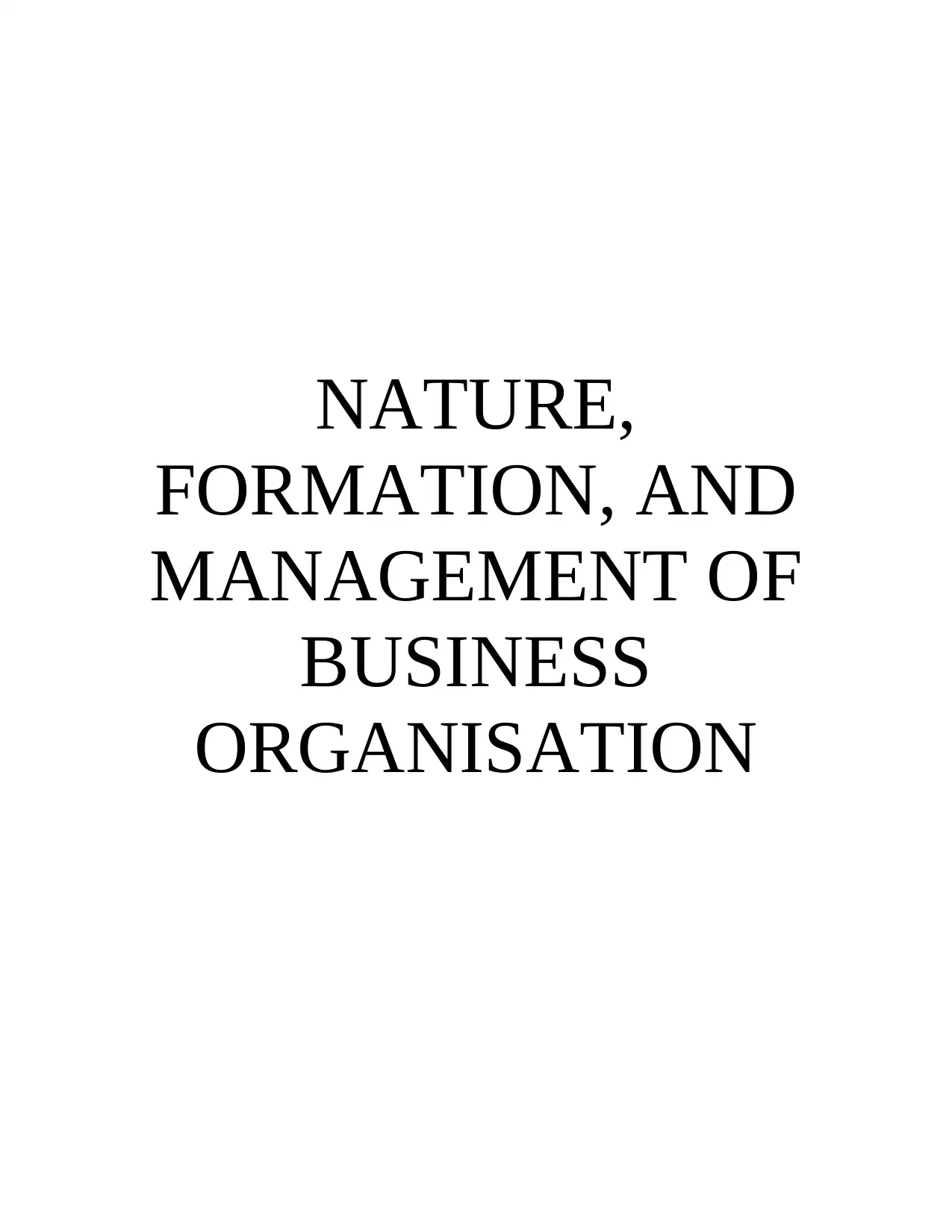
NATURE,
FORMATION, AND
MANAGEMENT OF
BUSINESS
ORGANISATION
FORMATION, AND
MANAGEMENT OF
BUSINESS
ORGANISATION
Paraphrase This Document
Need a fresh take? Get an instant paraphrase of this document with our AI Paraphraser
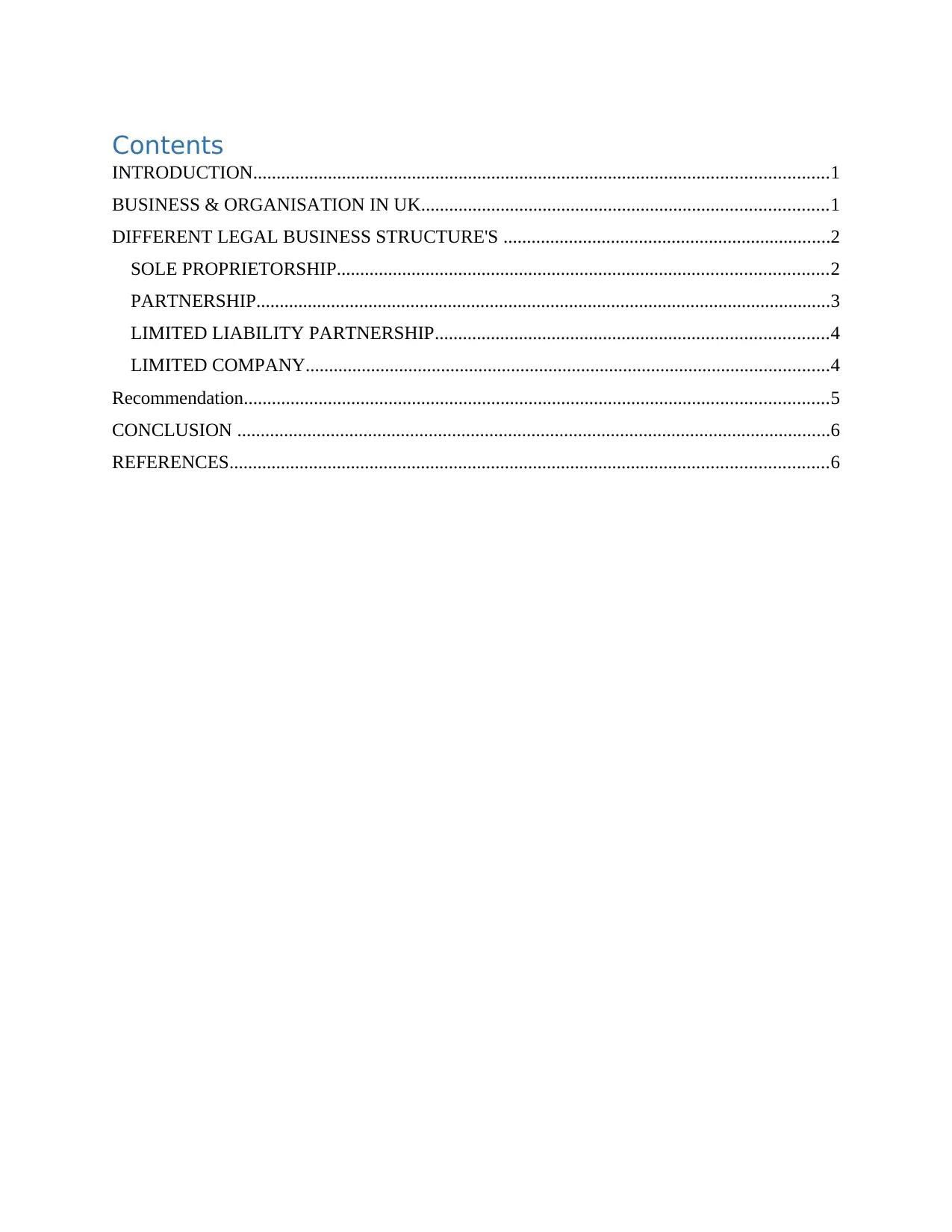
Contents
INTRODUCTION...........................................................................................................................1
BUSINESS & ORGANISATION IN UK.......................................................................................1
DIFFERENT LEGAL BUSINESS STRUCTURE'S ......................................................................2
SOLE PROPRIETORSHIP.........................................................................................................2
PARTNERSHIP...........................................................................................................................3
LIMITED LIABILITY PARTNERSHIP....................................................................................4
LIMITED COMPANY................................................................................................................4
Recommendation.............................................................................................................................5
CONCLUSION ...............................................................................................................................6
REFERENCES................................................................................................................................6
INTRODUCTION...........................................................................................................................1
BUSINESS & ORGANISATION IN UK.......................................................................................1
DIFFERENT LEGAL BUSINESS STRUCTURE'S ......................................................................2
SOLE PROPRIETORSHIP.........................................................................................................2
PARTNERSHIP...........................................................................................................................3
LIMITED LIABILITY PARTNERSHIP....................................................................................4
LIMITED COMPANY................................................................................................................4
Recommendation.............................................................................................................................5
CONCLUSION ...............................................................................................................................6
REFERENCES................................................................................................................................6

⊘ This is a preview!⊘
Do you want full access?
Subscribe today to unlock all pages.

Trusted by 1+ million students worldwide
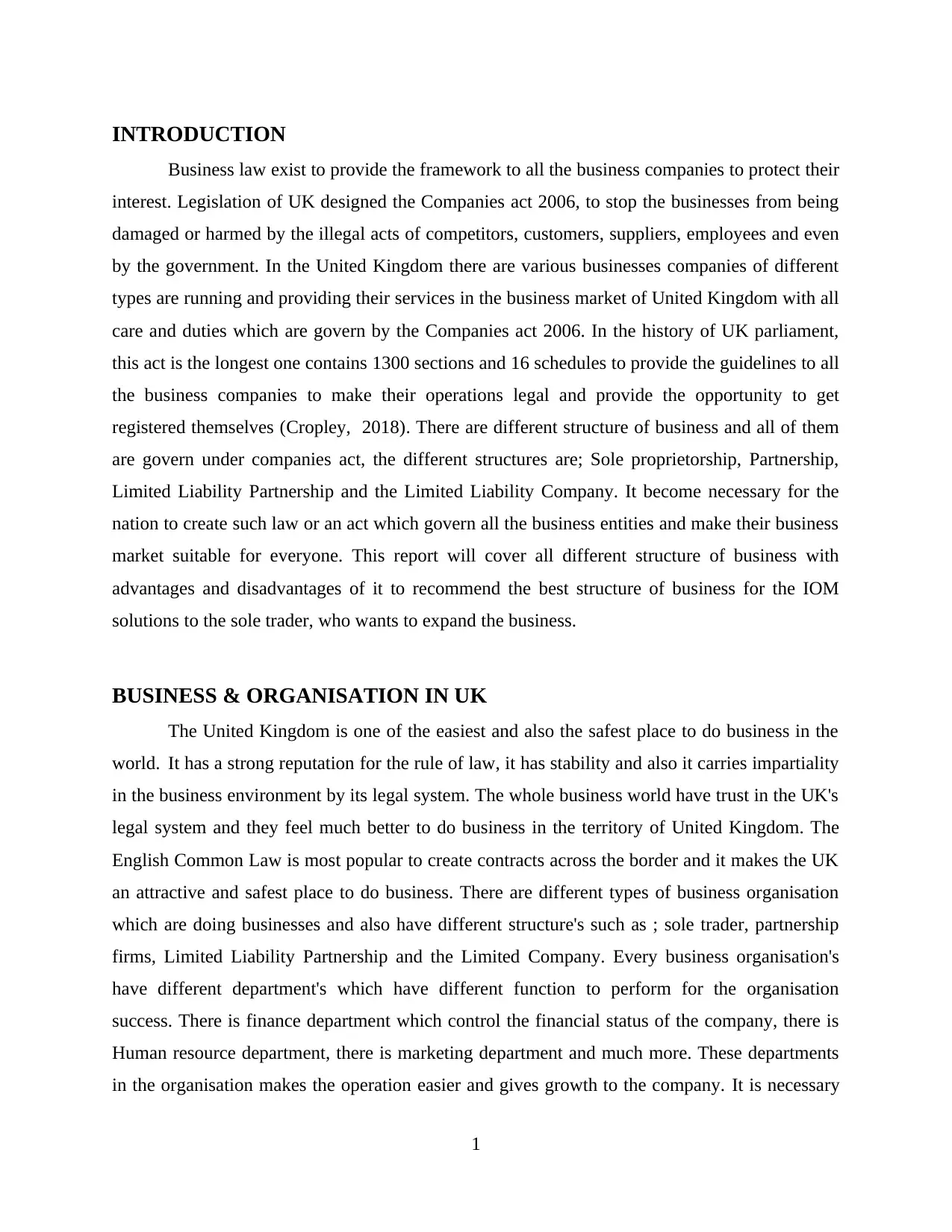
INTRODUCTION
Business law exist to provide the framework to all the business companies to protect their
interest. Legislation of UK designed the Companies act 2006, to stop the businesses from being
damaged or harmed by the illegal acts of competitors, customers, suppliers, employees and even
by the government. In the United Kingdom there are various businesses companies of different
types are running and providing their services in the business market of United Kingdom with all
care and duties which are govern by the Companies act 2006. In the history of UK parliament,
this act is the longest one contains 1300 sections and 16 schedules to provide the guidelines to all
the business companies to make their operations legal and provide the opportunity to get
registered themselves (Cropley, 2018). There are different structure of business and all of them
are govern under companies act, the different structures are; Sole proprietorship, Partnership,
Limited Liability Partnership and the Limited Liability Company. It become necessary for the
nation to create such law or an act which govern all the business entities and make their business
market suitable for everyone. This report will cover all different structure of business with
advantages and disadvantages of it to recommend the best structure of business for the IOM
solutions to the sole trader, who wants to expand the business.
BUSINESS & ORGANISATION IN UK
The United Kingdom is one of the easiest and also the safest place to do business in the
world. It has a strong reputation for the rule of law, it has stability and also it carries impartiality
in the business environment by its legal system. The whole business world have trust in the UK's
legal system and they feel much better to do business in the territory of United Kingdom. The
English Common Law is most popular to create contracts across the border and it makes the UK
an attractive and safest place to do business. There are different types of business organisation
which are doing businesses and also have different structure's such as ; sole trader, partnership
firms, Limited Liability Partnership and the Limited Company. Every business organisation's
have different department's which have different function to perform for the organisation
success. There is finance department which control the financial status of the company, there is
Human resource department, there is marketing department and much more. These departments
in the organisation makes the operation easier and gives growth to the company. It is necessary
1
Business law exist to provide the framework to all the business companies to protect their
interest. Legislation of UK designed the Companies act 2006, to stop the businesses from being
damaged or harmed by the illegal acts of competitors, customers, suppliers, employees and even
by the government. In the United Kingdom there are various businesses companies of different
types are running and providing their services in the business market of United Kingdom with all
care and duties which are govern by the Companies act 2006. In the history of UK parliament,
this act is the longest one contains 1300 sections and 16 schedules to provide the guidelines to all
the business companies to make their operations legal and provide the opportunity to get
registered themselves (Cropley, 2018). There are different structure of business and all of them
are govern under companies act, the different structures are; Sole proprietorship, Partnership,
Limited Liability Partnership and the Limited Liability Company. It become necessary for the
nation to create such law or an act which govern all the business entities and make their business
market suitable for everyone. This report will cover all different structure of business with
advantages and disadvantages of it to recommend the best structure of business for the IOM
solutions to the sole trader, who wants to expand the business.
BUSINESS & ORGANISATION IN UK
The United Kingdom is one of the easiest and also the safest place to do business in the
world. It has a strong reputation for the rule of law, it has stability and also it carries impartiality
in the business environment by its legal system. The whole business world have trust in the UK's
legal system and they feel much better to do business in the territory of United Kingdom. The
English Common Law is most popular to create contracts across the border and it makes the UK
an attractive and safest place to do business. There are different types of business organisation
which are doing businesses and also have different structure's such as ; sole trader, partnership
firms, Limited Liability Partnership and the Limited Company. Every business organisation's
have different department's which have different function to perform for the organisation
success. There is finance department which control the financial status of the company, there is
Human resource department, there is marketing department and much more. These departments
in the organisation makes the operation easier and gives growth to the company. It is necessary
1
Paraphrase This Document
Need a fresh take? Get an instant paraphrase of this document with our AI Paraphraser
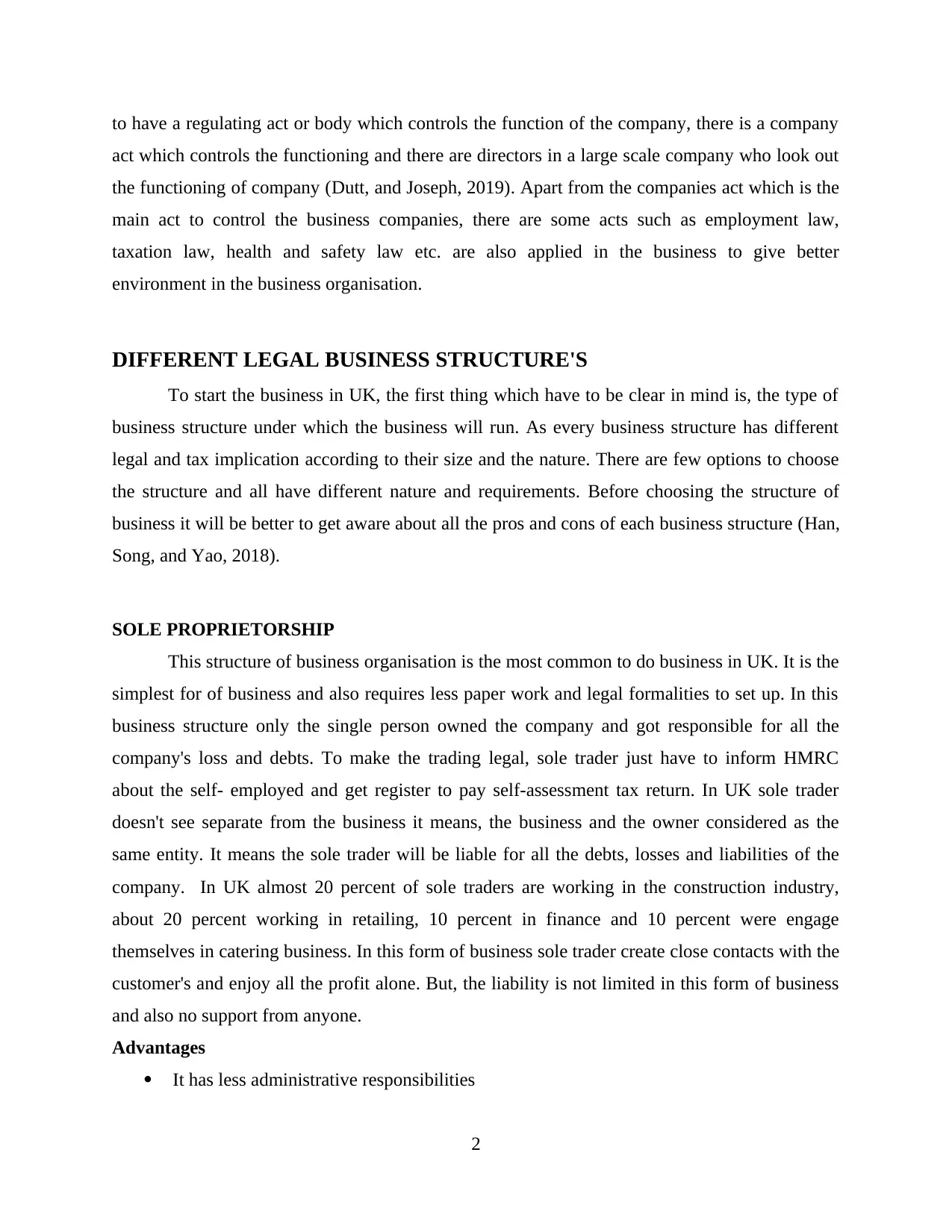
to have a regulating act or body which controls the function of the company, there is a company
act which controls the functioning and there are directors in a large scale company who look out
the functioning of company (Dutt, and Joseph, 2019). Apart from the companies act which is the
main act to control the business companies, there are some acts such as employment law,
taxation law, health and safety law etc. are also applied in the business to give better
environment in the business organisation.
DIFFERENT LEGAL BUSINESS STRUCTURE'S
To start the business in UK, the first thing which have to be clear in mind is, the type of
business structure under which the business will run. As every business structure has different
legal and tax implication according to their size and the nature. There are few options to choose
the structure and all have different nature and requirements. Before choosing the structure of
business it will be better to get aware about all the pros and cons of each business structure (Han,
Song, and Yao, 2018).
SOLE PROPRIETORSHIP
This structure of business organisation is the most common to do business in UK. It is the
simplest for of business and also requires less paper work and legal formalities to set up. In this
business structure only the single person owned the company and got responsible for all the
company's loss and debts. To make the trading legal, sole trader just have to inform HMRC
about the self- employed and get register to pay self-assessment tax return. In UK sole trader
doesn't see separate from the business it means, the business and the owner considered as the
same entity. It means the sole trader will be liable for all the debts, losses and liabilities of the
company. In UK almost 20 percent of sole traders are working in the construction industry,
about 20 percent working in retailing, 10 percent in finance and 10 percent were engage
themselves in catering business. In this form of business sole trader create close contacts with the
customer's and enjoy all the profit alone. But, the liability is not limited in this form of business
and also no support from anyone.
Advantages
It has less administrative responsibilities
2
act which controls the functioning and there are directors in a large scale company who look out
the functioning of company (Dutt, and Joseph, 2019). Apart from the companies act which is the
main act to control the business companies, there are some acts such as employment law,
taxation law, health and safety law etc. are also applied in the business to give better
environment in the business organisation.
DIFFERENT LEGAL BUSINESS STRUCTURE'S
To start the business in UK, the first thing which have to be clear in mind is, the type of
business structure under which the business will run. As every business structure has different
legal and tax implication according to their size and the nature. There are few options to choose
the structure and all have different nature and requirements. Before choosing the structure of
business it will be better to get aware about all the pros and cons of each business structure (Han,
Song, and Yao, 2018).
SOLE PROPRIETORSHIP
This structure of business organisation is the most common to do business in UK. It is the
simplest for of business and also requires less paper work and legal formalities to set up. In this
business structure only the single person owned the company and got responsible for all the
company's loss and debts. To make the trading legal, sole trader just have to inform HMRC
about the self- employed and get register to pay self-assessment tax return. In UK sole trader
doesn't see separate from the business it means, the business and the owner considered as the
same entity. It means the sole trader will be liable for all the debts, losses and liabilities of the
company. In UK almost 20 percent of sole traders are working in the construction industry,
about 20 percent working in retailing, 10 percent in finance and 10 percent were engage
themselves in catering business. In this form of business sole trader create close contacts with the
customer's and enjoy all the profit alone. But, the liability is not limited in this form of business
and also no support from anyone.
Advantages
It has less administrative responsibilities
2
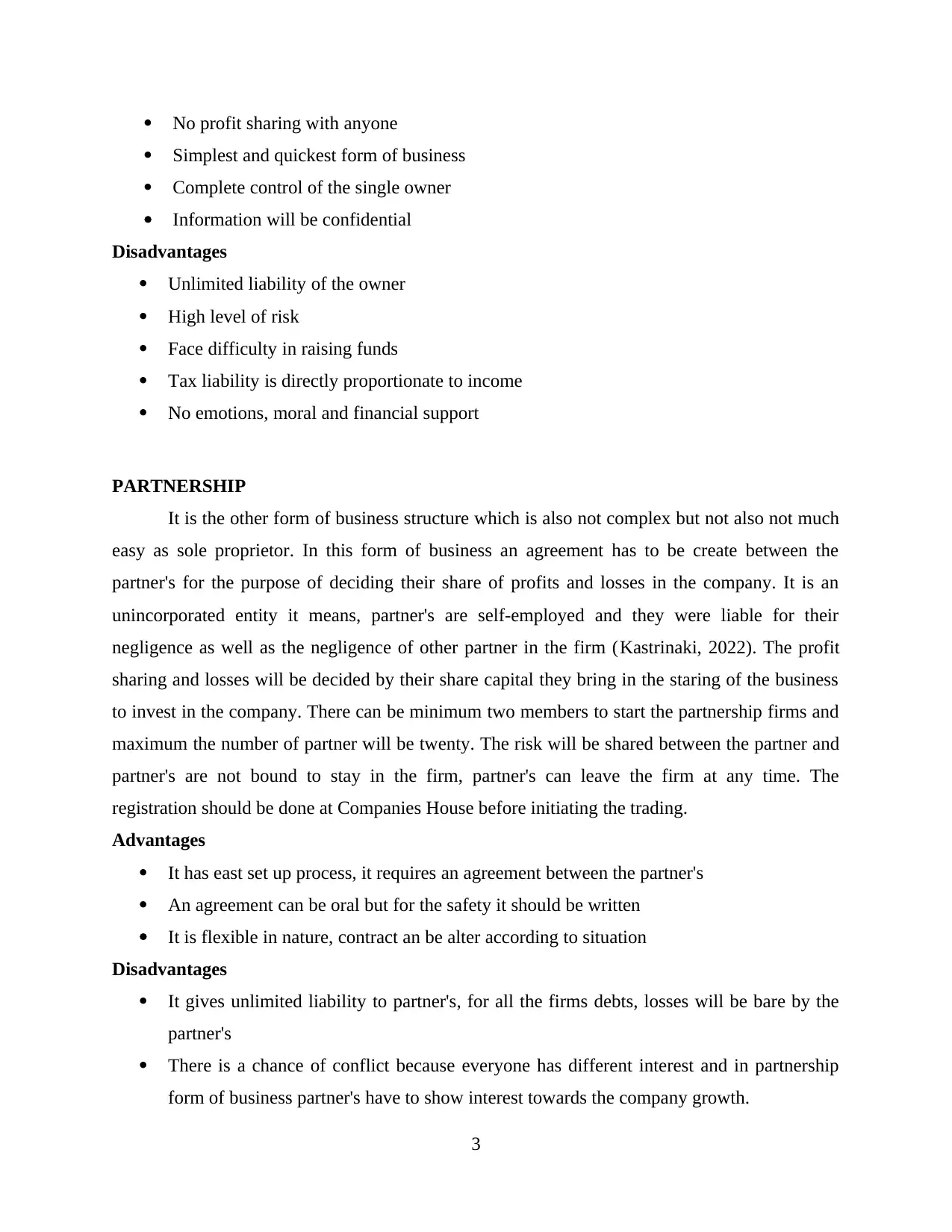
No profit sharing with anyone
Simplest and quickest form of business
Complete control of the single owner
Information will be confidential
Disadvantages
Unlimited liability of the owner
High level of risk
Face difficulty in raising funds
Tax liability is directly proportionate to income
No emotions, moral and financial support
PARTNERSHIP
It is the other form of business structure which is also not complex but not also not much
easy as sole proprietor. In this form of business an agreement has to be create between the
partner's for the purpose of deciding their share of profits and losses in the company. It is an
unincorporated entity it means, partner's are self-employed and they were liable for their
negligence as well as the negligence of other partner in the firm (Kastrinaki, 2022). The profit
sharing and losses will be decided by their share capital they bring in the staring of the business
to invest in the company. There can be minimum two members to start the partnership firms and
maximum the number of partner will be twenty. The risk will be shared between the partner and
partner's are not bound to stay in the firm, partner's can leave the firm at any time. The
registration should be done at Companies House before initiating the trading.
Advantages
It has east set up process, it requires an agreement between the partner's
An agreement can be oral but for the safety it should be written
It is flexible in nature, contract an be alter according to situation
Disadvantages
It gives unlimited liability to partner's, for all the firms debts, losses will be bare by the
partner's
There is a chance of conflict because everyone has different interest and in partnership
form of business partner's have to show interest towards the company growth.
3
Simplest and quickest form of business
Complete control of the single owner
Information will be confidential
Disadvantages
Unlimited liability of the owner
High level of risk
Face difficulty in raising funds
Tax liability is directly proportionate to income
No emotions, moral and financial support
PARTNERSHIP
It is the other form of business structure which is also not complex but not also not much
easy as sole proprietor. In this form of business an agreement has to be create between the
partner's for the purpose of deciding their share of profits and losses in the company. It is an
unincorporated entity it means, partner's are self-employed and they were liable for their
negligence as well as the negligence of other partner in the firm (Kastrinaki, 2022). The profit
sharing and losses will be decided by their share capital they bring in the staring of the business
to invest in the company. There can be minimum two members to start the partnership firms and
maximum the number of partner will be twenty. The risk will be shared between the partner and
partner's are not bound to stay in the firm, partner's can leave the firm at any time. The
registration should be done at Companies House before initiating the trading.
Advantages
It has east set up process, it requires an agreement between the partner's
An agreement can be oral but for the safety it should be written
It is flexible in nature, contract an be alter according to situation
Disadvantages
It gives unlimited liability to partner's, for all the firms debts, losses will be bare by the
partner's
There is a chance of conflict because everyone has different interest and in partnership
form of business partner's have to show interest towards the company growth.
3
⊘ This is a preview!⊘
Do you want full access?
Subscribe today to unlock all pages.

Trusted by 1+ million students worldwide
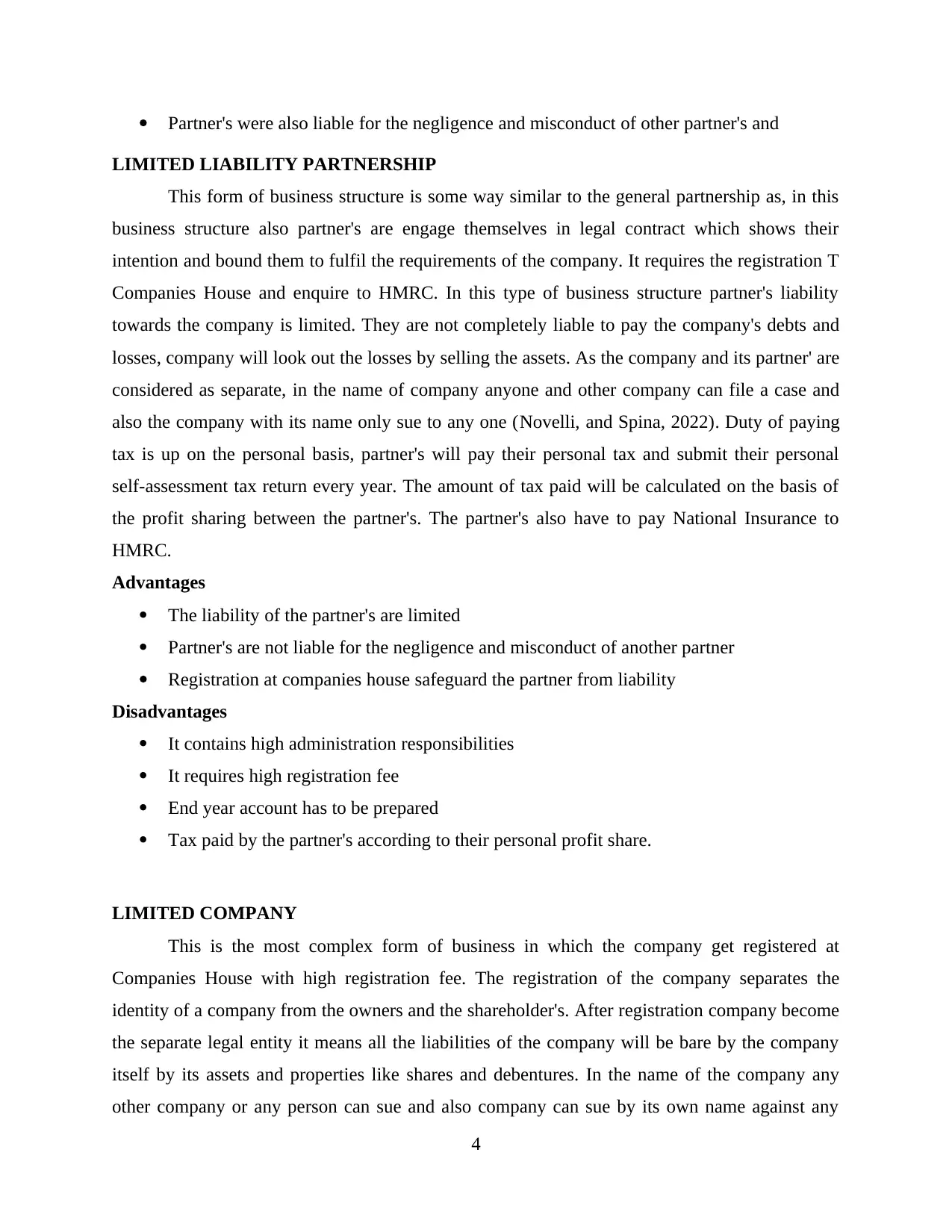
Partner's were also liable for the negligence and misconduct of other partner's and
LIMITED LIABILITY PARTNERSHIP
This form of business structure is some way similar to the general partnership as, in this
business structure also partner's are engage themselves in legal contract which shows their
intention and bound them to fulfil the requirements of the company. It requires the registration T
Companies House and enquire to HMRC. In this type of business structure partner's liability
towards the company is limited. They are not completely liable to pay the company's debts and
losses, company will look out the losses by selling the assets. As the company and its partner' are
considered as separate, in the name of company anyone and other company can file a case and
also the company with its name only sue to any one (Novelli, and Spina, 2022). Duty of paying
tax is up on the personal basis, partner's will pay their personal tax and submit their personal
self-assessment tax return every year. The amount of tax paid will be calculated on the basis of
the profit sharing between the partner's. The partner's also have to pay National Insurance to
HMRC.
Advantages
The liability of the partner's are limited
Partner's are not liable for the negligence and misconduct of another partner
Registration at companies house safeguard the partner from liability
Disadvantages
It contains high administration responsibilities
It requires high registration fee
End year account has to be prepared
Tax paid by the partner's according to their personal profit share.
LIMITED COMPANY
This is the most complex form of business in which the company get registered at
Companies House with high registration fee. The registration of the company separates the
identity of a company from the owners and the shareholder's. After registration company become
the separate legal entity it means all the liabilities of the company will be bare by the company
itself by its assets and properties like shares and debentures. In the name of the company any
other company or any person can sue and also company can sue by its own name against any
4
LIMITED LIABILITY PARTNERSHIP
This form of business structure is some way similar to the general partnership as, in this
business structure also partner's are engage themselves in legal contract which shows their
intention and bound them to fulfil the requirements of the company. It requires the registration T
Companies House and enquire to HMRC. In this type of business structure partner's liability
towards the company is limited. They are not completely liable to pay the company's debts and
losses, company will look out the losses by selling the assets. As the company and its partner' are
considered as separate, in the name of company anyone and other company can file a case and
also the company with its name only sue to any one (Novelli, and Spina, 2022). Duty of paying
tax is up on the personal basis, partner's will pay their personal tax and submit their personal
self-assessment tax return every year. The amount of tax paid will be calculated on the basis of
the profit sharing between the partner's. The partner's also have to pay National Insurance to
HMRC.
Advantages
The liability of the partner's are limited
Partner's are not liable for the negligence and misconduct of another partner
Registration at companies house safeguard the partner from liability
Disadvantages
It contains high administration responsibilities
It requires high registration fee
End year account has to be prepared
Tax paid by the partner's according to their personal profit share.
LIMITED COMPANY
This is the most complex form of business in which the company get registered at
Companies House with high registration fee. The registration of the company separates the
identity of a company from the owners and the shareholder's. After registration company become
the separate legal entity it means all the liabilities of the company will be bare by the company
itself by its assets and properties like shares and debentures. In the name of the company any
other company or any person can sue and also company can sue by its own name against any
4
Paraphrase This Document
Need a fresh take? Get an instant paraphrase of this document with our AI Paraphraser
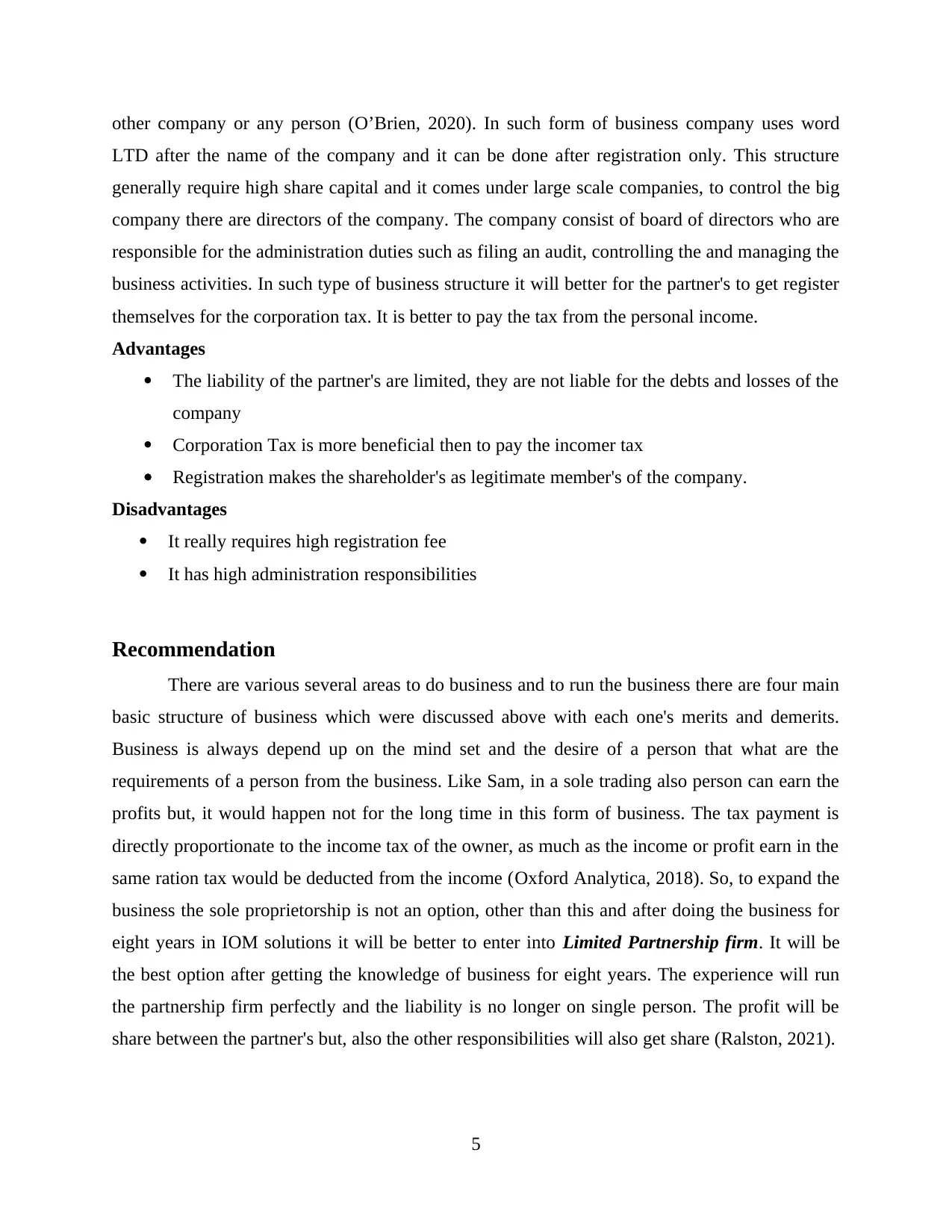
other company or any person (O’Brien, 2020). In such form of business company uses word
LTD after the name of the company and it can be done after registration only. This structure
generally require high share capital and it comes under large scale companies, to control the big
company there are directors of the company. The company consist of board of directors who are
responsible for the administration duties such as filing an audit, controlling the and managing the
business activities. In such type of business structure it will better for the partner's to get register
themselves for the corporation tax. It is better to pay the tax from the personal income.
Advantages
The liability of the partner's are limited, they are not liable for the debts and losses of the
company
Corporation Tax is more beneficial then to pay the incomer tax
Registration makes the shareholder's as legitimate member's of the company.
Disadvantages
It really requires high registration fee
It has high administration responsibilities
Recommendation
There are various several areas to do business and to run the business there are four main
basic structure of business which were discussed above with each one's merits and demerits.
Business is always depend up on the mind set and the desire of a person that what are the
requirements of a person from the business. Like Sam, in a sole trading also person can earn the
profits but, it would happen not for the long time in this form of business. The tax payment is
directly proportionate to the income tax of the owner, as much as the income or profit earn in the
same ration tax would be deducted from the income (Oxford Analytica, 2018). So, to expand the
business the sole proprietorship is not an option, other than this and after doing the business for
eight years in IOM solutions it will be better to enter into Limited Partnership firm. It will be
the best option after getting the knowledge of business for eight years. The experience will run
the partnership firm perfectly and the liability is no longer on single person. The profit will be
share between the partner's but, also the other responsibilities will also get share (Ralston, 2021).
5
LTD after the name of the company and it can be done after registration only. This structure
generally require high share capital and it comes under large scale companies, to control the big
company there are directors of the company. The company consist of board of directors who are
responsible for the administration duties such as filing an audit, controlling the and managing the
business activities. In such type of business structure it will better for the partner's to get register
themselves for the corporation tax. It is better to pay the tax from the personal income.
Advantages
The liability of the partner's are limited, they are not liable for the debts and losses of the
company
Corporation Tax is more beneficial then to pay the incomer tax
Registration makes the shareholder's as legitimate member's of the company.
Disadvantages
It really requires high registration fee
It has high administration responsibilities
Recommendation
There are various several areas to do business and to run the business there are four main
basic structure of business which were discussed above with each one's merits and demerits.
Business is always depend up on the mind set and the desire of a person that what are the
requirements of a person from the business. Like Sam, in a sole trading also person can earn the
profits but, it would happen not for the long time in this form of business. The tax payment is
directly proportionate to the income tax of the owner, as much as the income or profit earn in the
same ration tax would be deducted from the income (Oxford Analytica, 2018). So, to expand the
business the sole proprietorship is not an option, other than this and after doing the business for
eight years in IOM solutions it will be better to enter into Limited Partnership firm. It will be
the best option after getting the knowledge of business for eight years. The experience will run
the partnership firm perfectly and the liability is no longer on single person. The profit will be
share between the partner's but, also the other responsibilities will also get share (Ralston, 2021).
5

CONCLUSION
From the above report, in which all the structure of business got discuss i.e. sole
proprietorship, Partnership, Limited Liability Partnership and the Limited Company. These
structure discussed along with the advantages and disadvantages of all of them. The UK business
environment would also got explained and the form of business and organisation's would also
discussed. The discussion on all these topics would get done to give the suggestion to the sole
trader on expanding the business. The recommendation would also made in the end of the report
in which Limited Liability Partnership got suggested with all its benefits and cons. It is the best
option for Sam to expand the business.
REFERENCES
Books and Journals:
Cropley, J., 2018. Business and economics: United Kingdom. In Manual of Online Search
Strategies (pp. 483-534). Routledge.
Dutt, N. and Joseph, J., 2019. Regulatory uncertainty, corporate structure, and strategic agendas:
Evidence from the US renewable electricity industry. Academy of Management
Journal, 62(3), pp.800-827.
Han, X., Song, G. and Yao, R., 2018. Transformation of industrial land and urban regeneration
with a perspective of sustainable development-revelation of the Oracle on local changes
in Reading, UK. Journal of Xi'an University of Architecture and Technology, 50(4),
pp.536-542.
Kastrinaki, Z., 2022. The Role of the Board of Directors in Corporate Philanthropy: An
Empirical Study of UK Insurance Firms. In Corporate Social Responsibility and
Governance (pp. 79-102). Routledge.
Novelli, E. and Spina, C., 2022. When do Entrepreneurs Benefit from Acting Like Scientists? A
Field Experiment in the UK.
O’Brien, G., 2020. Protecting trade through war: Choctaw elites and British occupation of the
Floridas. In Empire and others: British encounters with indigenous peoples, 1600–
1850 (pp. 149-166). Routledge.
Oxford Analytica, 2018. UK industrial strategy impact rests on implementation. Emerald Expert
Briefings, (oxan-db).
Ralston, R., 2021. The informal governance of public-private partnerships in UK obesity policy:
Collaborating on calorie reduction or reducing effectiveness?. Social Science &
Medicine, 289, p.114451.
6
From the above report, in which all the structure of business got discuss i.e. sole
proprietorship, Partnership, Limited Liability Partnership and the Limited Company. These
structure discussed along with the advantages and disadvantages of all of them. The UK business
environment would also got explained and the form of business and organisation's would also
discussed. The discussion on all these topics would get done to give the suggestion to the sole
trader on expanding the business. The recommendation would also made in the end of the report
in which Limited Liability Partnership got suggested with all its benefits and cons. It is the best
option for Sam to expand the business.
REFERENCES
Books and Journals:
Cropley, J., 2018. Business and economics: United Kingdom. In Manual of Online Search
Strategies (pp. 483-534). Routledge.
Dutt, N. and Joseph, J., 2019. Regulatory uncertainty, corporate structure, and strategic agendas:
Evidence from the US renewable electricity industry. Academy of Management
Journal, 62(3), pp.800-827.
Han, X., Song, G. and Yao, R., 2018. Transformation of industrial land and urban regeneration
with a perspective of sustainable development-revelation of the Oracle on local changes
in Reading, UK. Journal of Xi'an University of Architecture and Technology, 50(4),
pp.536-542.
Kastrinaki, Z., 2022. The Role of the Board of Directors in Corporate Philanthropy: An
Empirical Study of UK Insurance Firms. In Corporate Social Responsibility and
Governance (pp. 79-102). Routledge.
Novelli, E. and Spina, C., 2022. When do Entrepreneurs Benefit from Acting Like Scientists? A
Field Experiment in the UK.
O’Brien, G., 2020. Protecting trade through war: Choctaw elites and British occupation of the
Floridas. In Empire and others: British encounters with indigenous peoples, 1600–
1850 (pp. 149-166). Routledge.
Oxford Analytica, 2018. UK industrial strategy impact rests on implementation. Emerald Expert
Briefings, (oxan-db).
Ralston, R., 2021. The informal governance of public-private partnerships in UK obesity policy:
Collaborating on calorie reduction or reducing effectiveness?. Social Science &
Medicine, 289, p.114451.
6
⊘ This is a preview!⊘
Do you want full access?
Subscribe today to unlock all pages.

Trusted by 1+ million students worldwide
1 out of 9
Related Documents
Your All-in-One AI-Powered Toolkit for Academic Success.
+13062052269
info@desklib.com
Available 24*7 on WhatsApp / Email
![[object Object]](/_next/static/media/star-bottom.7253800d.svg)
Unlock your academic potential
Copyright © 2020–2025 A2Z Services. All Rights Reserved. Developed and managed by ZUCOL.


